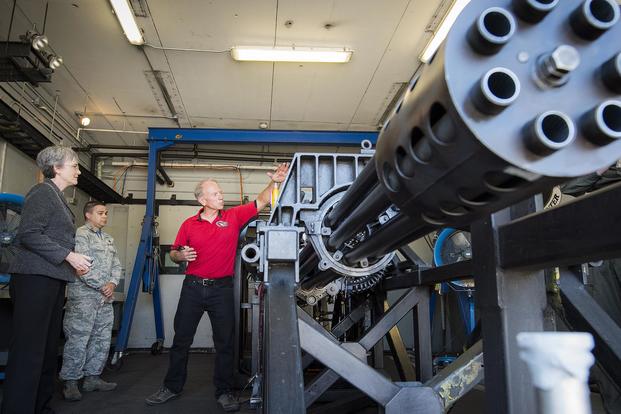EGLIN AIR FORCE BASE, Florida -- If the Air Force is going to keep its A-10 Thunderbolt II fleet flying through 2030, it'll need more than just new wings. It's also going to need new ammo.
The service is deliberating how best to acquire more PGU-14 ammunition, currently made by Orbital ATK, for the A-10 as its existing bullet inventory -- averaging 32 years old -- is beginning to age out, said Bob DuPont of the 780th Test Squadron's guns and missiles department.
It is unknown if the Air Force will stick with 30mm depleted-uranium (DU) bullets or if it will switch to a tungsten round.
"There's a lot of discussion of whether we're going to use depleted uranium again, or the tungsten penetrator," DuPont said before a live-fire exercise here at the base May 4.
During the exercise, Military.com accompanied Air Force Secretary Heather Wilson and got a taste of how the A-10's GAU-8/A gun system not only brings the notorious brrrrrrrttt sound but also takes out targets in a close-support mission scenario.
Related content:
- Advanced Data Sharing, Range Expansion on Eglin Test Wing's Agenda
- With Older F-35s 'On Life Support,' Wing Struggles to Train Pilots
- Air Force Readies Competition to Re-Wing A-10s
In 2015, the Defense Department said it was not using depleted uranium bullets in the fight against the Islamic State in Iraq and Syria. But months later, during an offensive strike dubbed Operation Tidal Wave II, mission planners changed their minds and used the slightly radioactive weapon against ISIS oil trucks in the Syrian desert, according to a report from The Washington Post.
Eglin officials could not speak to whether the A-10 has fired the DU ammo recently in combat.
Depleted uranium is used for its ability to pierce armored vehicles, as it is 60 percent more dense than lead. DU has "40 percent less radioactivity, but the same chemical toxicity as natural uranium," according to the Department of Veterans Affairs Public Health description of the substance.
Aware of environmental and health concerns, officials at Eglin are weighing battle scenarios in which DU bullets are a must and when the tungsten alternative could be used.
Tungsten is comparable to uranium but a bit less dense, so manufacturers must balance out the weight to match today's PGU-14 rounds, which weigh roughly 14 ounces each.
"We're going to try to keep the weight the same, but it will have a less penetration capability because of the density of the material, DU being more dense than tungsten," DuPont said.
He said the service is reaching out to the defense industry to see if adding a mix of alloy samples will allow tungsten to meet requirements. "We're trying to make sure tungsten offers us a [suitable] alternative and, if it does, we'll go use tungsten."
DuPont said using depleted uranium is not off the table but no matter the choice, "we've got to buy new."
DU PGU-14 bullets are tested every two years on the base's northern range in a controlled fire exercise, something required by the Pentagon for the ammo to be recertified for use in combat.
When the A-10's GAU-8/A Gatling-style autocannon is fully loaded, it weighs roughly 4,000 pounds, DuPont said. "It is the largest flying Gatling gun in the world today."
Analysts and engineers from the 780th, using a test round called PGU-15, look for what's called relevant action time. They will watch the sequence of "when the firing pin strikes the primer, until the projectile exits at the muzzle, which is very important in the Gatling gun because I have spinning barrels," DuPont said.
Sensors and microphones listen for the "blast event" to make sure the shot is not only achieved, but achieved on time.
"I have 4.5 milliseconds from the time I initiate that round to get the projectile out the muzzle. Anything beyond six milliseconds is catastrophic for this system," DuPont said.
Officials also look at velocity and accuracy, measured by boxes the ammunition pierces through on the range.
Watch here as Military.com observes 100 PGU-15 rounds come off the gun in just 2.1 seconds:












